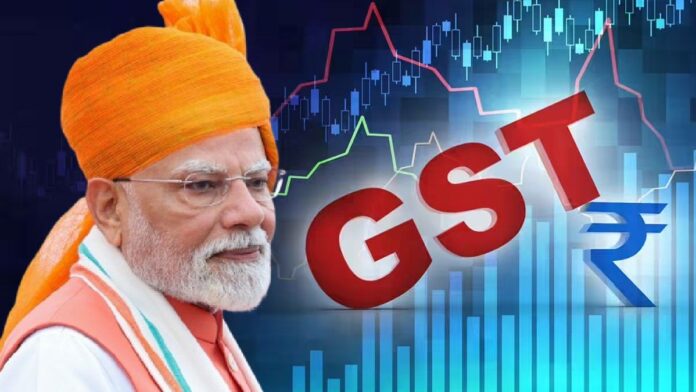Paromita Das
New Delhi, 23rd September: The verdict is in—Bharat has endorsed Narendra Modi for a historic third term as Prime Minister. With victory on the political front secured, Modi is now redefining economic priorities by shifting trust—and money—directly into the hands of the Bharatiya people. In a tectonic shift from earlier corporate-focused reforms, his new twin tax relief packages are poised to empower the middle class, Bharat’s core consumption engine, promising to set the economy roaring in the years ahead.
Reimagining Economic Growth: The GST Savings Festival

Addressing a hopeful nation, Modi announced the launch of the GST Bachat Utsav, a nationwide festival of savings, on September 22. Set against the backdrop of landmark income tax and GST reforms from the Budget 2025-26, this initiative marks the government’s conviction that Bharat’s burgeoning middle class will drive growth, consumption, and a brighter economic future. Private consumption comprised 61.4% of Bharat’s nominal GDP last fiscal year, making spending power central to the nation’s economic health.
This double bonanza—the GST rationalisation and income tax relief—will allow Bharatiya consumers to save over ₹2.5 lakh crore this year alone. For a broad swathe of the population, this means actual disposable income, fueling a virtuous cycle of demand, production, and prosperity.
Why the Middle Class Matters: From Corporate Scepticism to Consumer Power

Modi’s middle-class pivot comes after the government’s earlier experiment with boosting industry through corporate tax cuts fell flat. Despite slashing the base rate from 30% to 22% in 2019, big corporates failed to pass the benefits on. Job creation and real wage hikes lagged inflation. In two years, the tax break cost the government ₹1.84 lakh crore but yielded little for ordinary Bharatiya. Corporate taxes even fell below personal income tax collections, accentuating the rise in household contributions to the exchequer.
This disappointment led Modi to change course decisively. Instead of indirect incentives for industry, the government is now opting for direct relief to earners and spenders, recognizing the middle class—and the rising neo-middle class—as the true architects of “Viksit Bharat.”
Empowering the Aspirational Bharat

The government’s faith in this demographic is rooted in remarkable social mobility. Over the past few years, 25 crore people have risen above poverty to form a thriving neo-middle class. Modi made it clear: “This large group is playing a major role in the nation, with its own aspirations and dreams.” Tax reliefs enable them to save and spend more, while increased demand motivates manufacturing, job creation, and investment.
Underlying the initiative is a gamble: the government stands to lose ₹48,000 crore in annual GST revenue, but expects increased consumption and economic activity to recoup up to 10% of the shortfall. The ultimate goal is to cultivate inclusivity and opportunity for shopkeepers, entrepreneurs, traders, youth, farmers, and especially women—fostering equitable growth.
Viksit Bharat 2047: Ambition Meets Action

Bharat’s next challenge is ambitious growth: an 8% GDP rate on the path to becoming a fully developed nation by 2047. Modi’s economic blueprint depends on building not just prosperity, but resilience—in urban centers and villages, among the seasoned middle class and the newly empowered millions. The GST Savings Festival and ongoing manufacturing push are a calculated bet that a confident, spending-savvy public will propel Bharat to global leadership.
Betting on People, Not Just Profit

Modi’s gamble marks a watershed for Bharatiya policymaking—choosing consumers over corporates, aspiration over accumulation. Entrusting the nation’s economic destiny to the middle-class signals faith in millions who drive Bharat’s story forward with diligence and ambition. For critics who lament lost revenue or worry about short-term fiscal risks, the prospect of a consumption-led surge that builds businesses, amplifies jobs, and supports dreams is cause for optimism.
There is risk, of course: global headwinds, inflation, and inadequate manufacturing growth could challenge the strategy. Still, this vote of confidence in the people is refreshing, aligning state intent with the everyday aspirations of Bharat’s citizens.
The People’s Prosperity Era
Prime Minister Modi’s third term is not just about political continuity—it’s about a new contract with the middle class. The GST Bachat Utsav and renewed tax reliefs are more than numbers: they are a commitment to inclusive growth, national prosperity, and shared destiny. If Bharat’s people respond as hoped, spending and thriving, Modi’s “Viksit Bharat” vision for 2047 may yet be realized, marking a turning point where faith in the people truly powers the economy.
The post Economic Fireworks: GST and Tax Relief Spark a New Era appeared first on Global Governance News- Asia's First Bilingual News portal for Global News and Updates.



